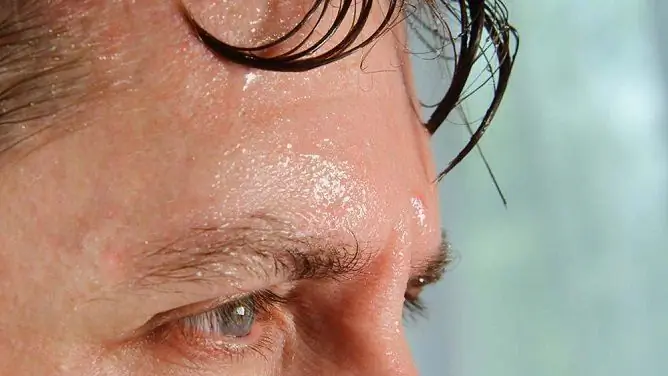- Author Rachel Wainwright [email protected].
- Public 2023-12-15 07:39.
- Last modified 2025-11-02 20:14.
Hyperhidrosis: what is it, causes, treatment
The content of the article:
- Forms of pathology
- Sweat and sweat glands
-
Causes of hyperhidrosis
- Primary hyperhidrosis
-
Secondary hyperhidrosis
- Infectious diseases
- Neurological diseases
- Autoimmune diseases
- The use of certain drugs
- Psychogenic factors
-
Treatment
- Drug treatment
- Sympathectomy
- Curettage
- Consequences of hyperhidrosis
- Video
Hyperhidrosis - what is it? Hyperhidrosis is a pathological condition characterized by excessive sweating. It can arise as a consequence of certain diseases or be an individual congenital feature.

Excessive sweating is a characteristic sign of pathology.
Excessive sweating is a fairly common occurrence; according to statistics, about 2% of people experience its manifestations. However, they rarely go to a doctor with such a problem, therefore it is believed that the real number of patients is much higher.
Forms of pathology
There are two forms of the disease:
| The form | Description |
| Local hyperhidrosis | In this case, the whole body sweats. |
| Local hyperhidrosis | Excessive sweating occurs on certain areas of the body: palms, feet, armpits |
In most patients, idiopathic hyperhidrosis occurs from time to time, in response to the action of certain stimuli (changes in hormonal levels, stress, alcohol consumption). But a small percentage of people have symptoms of the disease all the time.
By etiology, the disease is divided into two types:
| View | Description |
| Primary | Excessive sweating occurs in the absence of any pathologies |
| Secondary | Excessive sweating indicates the presence of certain medical conditions |
Sweat and sweat glands
Sweat is an aqueous solution containing calcium, phosphorus, potassium, uric acid, lactic acid and ammonia salts. It is secreted by sweat glands, of which there are more than 2.5 million on the human body. At normal ambient temperatures, 400 ml to 1 liter of sweat is released.

Sweat glands are responsible for the secretion of sweat
In hot weather or during physical exertion, the human body can excrete more than two liters of sweat, which is also a variant of the norm. At the exit from the sweat glands, this liquid is transparent and odorless. The bacteria that live on the skin give it a specific scent and a yellowish tint.
The sweat glands on the human body are subdivided as follows:
- apocrine. They are located in the groin and axillary region and secrete a whitish secretion containing fatty acids, cholesterol and other substances. It has a specific odor as it is a breeding ground for many bacteria. It is believed that the sweat secreted by the apocrine glands contains pheromones (substances that attract people of the opposite sex);
- eccrine. Are located on the face, chest, back, feet and palms. A transparent, odorless liquid is released, containing a large amount of salts and acids.
Through perspiration, the body regulates body temperature, preventing overheating. Also, sweat from the eccrine glands has an antibacterial effect, which prevents the growth of bacteria on the skin and prevents the development of inflammatory processes.
Causes of hyperhidrosis
The following factors fail to influence the perspiration process:
- increase in air temperature;
- stress;
- nervous tension;
- active physical activity;
- eating spicy or hot food.
Primary hyperhidrosis
The causes of primary hyperhidrosis include:
- hereditary predisposition;
- increased sensitivity of the body to the hormones norepinephrine and adrenaline;
- features of the nervous system, when a large number of nerve impulses are synthesized in the cortical centers and ganglia;
- high levels of sex hormones.
Secondary hyperhidrosis
Infectious diseases
The cause of increased sweating can be both acute and chronic forms of infectious diseases:
- flu;
- tonsillitis;
- malaria;
- syphilis;
- tuberculosis;
- brucellosis.
Neurological diseases
The centers of the autonomic nervous system, which are located in the spinal cord and brain, as well as sympathetic nerve nodes along the spine, are responsible for the regulation of sweating. If there is a failure in any area, this can cause hyperhidrosis.
Sweating can be caused by:
- concussion;
- spinal injury;
- inflammatory processes in soft tissues;
- Parkinson's disease;
- stroke;
- epilepsy;
- diencephalic syndrome in newborns.
Autoimmune diseases
There are diseases in which the body's own immune cells attack, causing disturbances in the functioning of internal organs. Excessive sweating can be caused by:
- rheumatoid arthritis;
- Raynaud's disease;
- systemic lupus erythematosus.
The use of certain drugs
Some medications affect the nervous system, thereby causing increased sweating. These drugs include:
- antiviral agents: Gerpevir, Acyclovir, Valavir;
- antibiotics: Ciprofloxacin, Erythromycin;
- antiemetic drugs: metoclopramide, Cerucal, Ondansetron;
- psychotropic drugs: Amitriptyline, Phenazepam, Azaleptin;
- anti-glaucoma drugs: Pilocarpine, Lanotan;
- hormonal agents: Prednisolone.
Psychogenic factors
In some cases, increased sweating can be caused by psychogenic factors:
- acute psychological trauma;
- psycho-emotional stress;
- neuroses;
- asthenia;
- psychological trauma;
- neurocircular dysfunction;
- strong pain.

Increased sweating can occur due to psycho-emotional stress
Treatment
For the diagnosis and treatment of the disease, it is necessary to consult an endocrinologist or therapist. The doctor will conduct a survey, determining when the symptoms of hyperhidrosis first appeared, if other family members have such symptoms. The specialist also clarifies in which situation sweating increases, and how much it interferes in everyday life.

To identify the causes of the disease and prescribe treatment, you must contact a therapist or endocrinologist
The doctor may order certain tests:
- general and biochemical blood test;
- analysis for hepatitis, HIV;
- fluorography;
- blood sugar test;
- blood test for thyroid hormones.
For diagnostic purposes, the Minor test (iodine starch test) is performed. It allows you to identify areas of increased sweating. Before it is carried out, the skin is dried, treated with an aqueous solution of iodine and sprinkled with starch. Areas where the sweat glands are too active turn blue. They are marked and photographed in order to carry out medical procedures.
Drug treatment
You can reduce sweating by taking drugs from the anticholinergic group. They block the transmission of impulses to the sweat glands, thereby reducing sweating. For the treatment of hyperhidrosis, Atropine, Scopolamine, Deprim Forte, Bellaspon, Bellataminal are used.
In most cases, the effect of the use of such drugs occurs 10-14 days after the start of admission. The course of therapy is usually 4 to 6 weeks.
The disadvantage of this method of treatment is that the drugs have a large number of contraindications. For the treatment of excessive sweating, high enough doses of drugs are required, which increases the likelihood of side effects.
Sympathectomy
This is a medical procedure in which nerve fibers that transmit impulses to the sweat glands are destroyed by means of current, laser, chemicals or surgical endoscopic equipment.
The disadvantage of this method is that scars or hematomas can form at the site of punctures or incisions. After surgery, half of the patients develop compensatory hyperhidrosis, in which excessive sweating occurs in the groin folds, on the legs or trunk.
Curettage
This treatment is used to eliminate excess underarm sweating. A surgical spoon (curette) is inserted through a small puncture and the sweat gland or part of the fatty tissue is removed.
The disadvantage of this method is the formation of scars, hematomas or growth of scar tissue. Also, this method of therapy has contraindications.
Consequences of hyperhidrosis
Hyperhidrosis significantly affects human life and provokes social problems. The patient feels uncomfortable in society, since the unpleasant smell of sweat causes hostility from others. With a severe form of the disease, the patient becomes withdrawn and rarely leaves the house.

Excessive sweating can seriously impair quality of life
Constant moisture of the skin leads to the appearance of various rashes provoked by a bacterial infection. Inflammation of the sweat glands in the armpit is common.
If excessive sweating is inconvenient and you cannot cope with it on your own, you should consult a doctor.
Video
We offer for viewing a video on the topic of the article.

Anna Kozlova Medical journalist About the author
Education: Rostov State Medical University, specialty "General Medicine".
The information is generalized and provided for informational purposes only. At the first sign of illness, see your doctor. Self-medication is hazardous to health!






